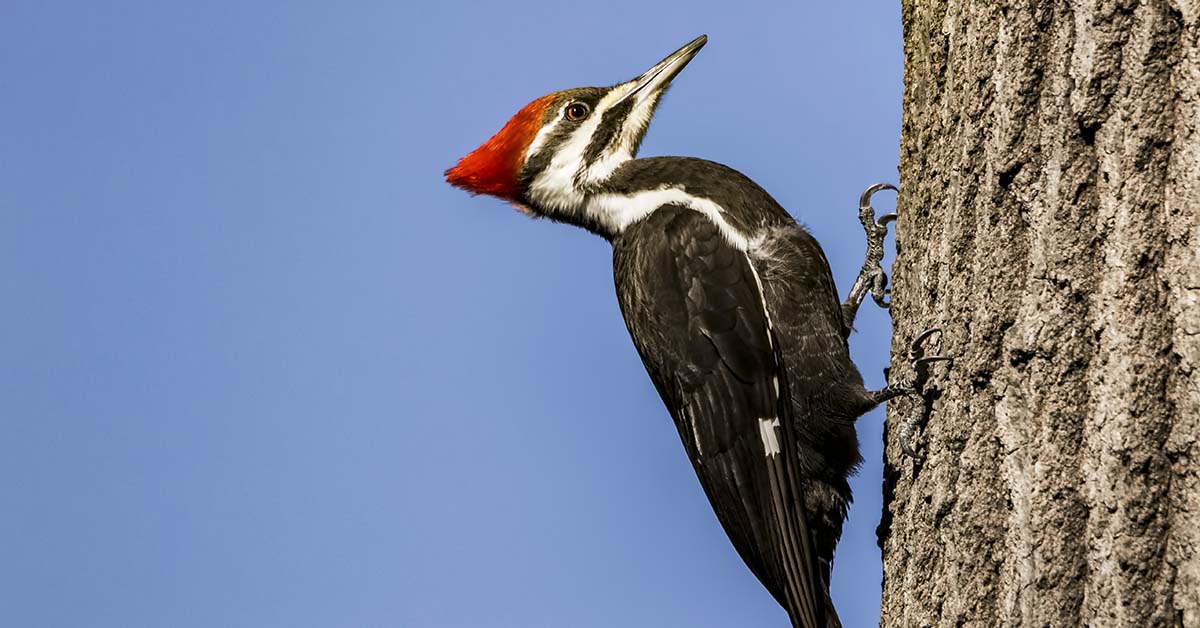If you’re an animal lover, you’ve likely spent a lot of time pondering the habits and lifestyles of animals. The woodpecker is particularly fascinating because it can bang its head against a tree. For most of us, that would cause a headache and brain damage. However, they’re somehow able to do so for hours.
Almost Worldwide Woodpecker
There are 200 species of woodpecker spanning almost all the continents, excluding Australis and Antarctica. Moreover, the different species have differing methods and sources for getting food, but they all seem to be able to hammer away for hours without any damaging repercussions. To find out the mystery behind the woodpecker, scientists from Beihang University in Bejing, China, investigated. Their findings were published in the journal PLOS One in 2011.
They chose two bird species, the Great Spotted Woodpecker and the Eurasian Hoopoe. Both are native to Eurasia, with the Spotted Woodpecker spanning places as far south as Southern Africa. Although the Eurasian Hoopoe isn’t classified as a woodpecker, it does peck at the soil, allowing for scientists to still accurately observe its hammering methods.
Conducting the Experiment
The experiment involved birds placed in metal cages with a force sensor. The force sensor allowed scientists to track how hard the birds were pecking. Furthermore, scientists were able to watch the birds in slow motion thanks to the use of high-speed cameras, which they then slowed down for observation using electron microscopy
Through this experiment, scientists stumbled upon a number of interesting findings. Firstly, they learned about the timing and speed of how the woodpecker and hoopoe peck for food. It turns out that there are two adaptations in the woodpecker, hoopoe, and other pecking birds that assist them in hammering away without causing damage or pain.
The first adaptation relates to bone and beak shape, using a built-in shock system. Shocks help make a car or bike ride much smoother, and they happen to work the same way for birds. Their beaks act as a shock system, and the bones in their skull protect the brain. A woodpecker hammers away, looking for food, with an estimated minimum of 1,000 times the force of gravity.
Therefore, the complex “shock system” in their brains is an evolutionary lifesaver; after all, they can peck for food without losing consciousness. Furthermore, shock absorption varies based on multiple factors.
Adaptations are the Answer
Some birds have a self-sharpening beak, meaning that it always smoothly glides into the wood, decreasing the force of the pecks, rather than hitting a hard surface and microscopically bouncing back or even becoming stuck. Meanwhile, some woodpeckers have a longer lower beak, directing energy away from the brain. Another factor in deciding shock absorption is how strong neck muscles support a small skull so the brain doesn’t move around as much, eliminating pain and discomfort.
The first adaptation is easy for people to observe whether or not they’re bird enthusiasts. All you’d need is to compare birds out in nature or images found on the computer to see that there are different shapes and sizes in most birds’ beaks and heads.
The second adaptation seems to be less commonly known and is only obvious to the most advanced bird enthusiasts, such as the scientists who conducted the woodpecker experiment. Apparently, the adaptation is a well-kept secret, which makes sense because it’s hidden in their tongues. Tongues are hidden in mouths and are often only revealed during a conversation. However, most birds don’t speak, so the best time to catch a glimpse of their little tongues is when they’re eating. For example, while eating ants from an anthill.
Read: Two decades after it vanished, the stunning Spix’s macaw returns to its forest home
A Woodpecker’s Diet
Woodpeckers are omnivores and therefore eat various nuts, seeds, fruits, saps, insects, spiders, and arthropods. While they don’t need their tongues to eat fruits or nuts, the tongue adaptation allows for them to gather food from small crevices, such as the aforementioned anthill, or from inside a tree. Their tongues vary in shape and size, but the adaptation is classified as such through one particular trait, barbed wiring.
How the Tongue Helps
Although the woodpecker’s tongue doesn’t actually consist of metal, there are “spikes” that resemble those in a bard wire fencing. These “spikes” are located near the backs of the woodpecker’s tongue and act as a spear. Grabbing and holding onto prey, the “spikes” prevent prey from escaping. Unsurprisingly, woodpeckers and Hoopoes also have sticky saliva, which works as an adhesive to further ensure their food won’t get away.
Moreover, the Hyoid bone is U-shaped and sits at the back of the tongue where the neck and jaw meet. While all vertebrates have the hyoid bone, Woodpeckers and Hoopoes have longer bones. This allows them to extend their tongue when necessary and keep it hidden the rest of the time.

Other Methods of Getting Food
In contrast, Flickers, timid and tiny birds, have flattened tongues, scarce in barbs. As a result, rely on their sticky saliva to keep hold of their prey. Frequently seen visiting anthills, the flickers are considered to have one of the longest tongues of any of the woodpecker species. Another bird with a differing method for retrieving food is the Pileated Woodpeckers.
Their tongue is relatively short so they’re most likely to be seen hammering trees in search of carpenter ants. Often mistaken for a woodpecker, the Sapsucker may have the most unusual tongue of many bird species. This is because their tongue is short and has bristles rather than barbs. As a result, and as their name implies, they live on the sweet sticky sap of trees. Occasionally, also eating the insects that are drawn to the trees’ sap wells.
Woodpeckers have long been a mystery because if people got their food the same way, we’d likely have far more hospital visits and brain damage. Fortunately, woodpeckers and other birds have effectively evolved without that problem!
Keep Reading: The Coconut Crab Kills Birds And Breaks Bones – And May Have Eaten Amelia Earhart Alive
Sources
- “Why don’t woodpeckers get headaches?” Live Science. Corey Binns. July 16, 2010
- “Why don’t woodpeckers get headaches?” Ask A Biologist. Retrieved March 16, 2023.
- “Why Do Woodpeckers Resist Head Impact Injury: A Biomechanical Investigation” PLOS One. October 26, 2011.

